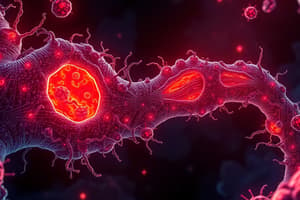Podcast
Questions and Answers
What is the primary function of digestive proteins in the human body?
What is the primary function of digestive proteins in the human body?
- To protect the body from foreign pathogens
- To coordinate the activity of different body systems
- To construct different body structures
- To break down food into monomeric units (correct)
What is the primary function of hemoglobin in the human body?
What is the primary function of hemoglobin in the human body?
- To digest food into monomeric units
- To carry oxygen in the blood (correct)
- To coordinate the activity of different body systems
- To construct different body structures
What is the primary function of actin and tubulin in the human body?
What is the primary function of actin and tubulin in the human body?
- To protect the body from foreign pathogens
- To coordinate the activity of different body systems
- To digest food into monomeric units
- To construct different body structures (correct)
What is the primary function of insulin and thyroxine in the human body?
What is the primary function of insulin and thyroxine in the human body?
What is the primary function of immunoglobulins in the human body?
What is the primary function of immunoglobulins in the human body?
What is the primary function of actin and myosin in the human body?
What is the primary function of actin and myosin in the human body?
What is the primary function of egg white (albumin) in the human body?
What is the primary function of egg white (albumin) in the human body?
What is the primary function of nucleic acids in the human body?
What is the primary function of nucleic acids in the human body?
What is the sugar molecule found in DNA nucleotides?
What is the sugar molecule found in DNA nucleotides?
What is the base found in RNA nucleotides that replaces thymine?
What is the base found in RNA nucleotides that replaces thymine?
Study Notes
Cell Structure
- Endoplasmic reticulum: present in both plant and animal cells, involved in molecule degradation of waste cellular products.
- Lysosomes: present in animal cells, contain digestive enzymes to break down cellular macromolecules; rarely present in plant cells.
- Vacuoles: present in both plant and animal cells, membrane-bound organelles that can contain water, inorganic and organic molecules, and enzymes in solution.
- Nucleus: present in both plant and animal cells, located at the center of the cell in plant cells and on the side of the cell in animal cells, contains genetic information.
- Centrioles: present in animal cells, involved in the cell division process; absent in plant cells.
- Microfilaments and microtubules: present in both plant and animal cells, involved in movement and cell division.
- Cilia and flagella: present in animal cells, involved in movement; absent in plant cells.
- Plastides: present in plant cells, involved in pigmentation and photosynthesis; absent in animal cells.
- Cell walls: present in plant cells, algae, fungi, and some bacteria, composed of various polysaccharides and polymers; absent in animal cells.
Cytoplasm
- Present in all types of cells, semi-fluid medium containing water and various molecules.
- Contains proteins, which account for its semi-fluid nature.
- Eukaryotic cells have organelles, which are internal compartments with specialized functions.
The Nucleus
- Stores genetic information in the form of DNA.
- Every cell in the body contains the same genes.
- Genes are segments of DNA that contain information for the production of specific proteins.
- DNA, with RNA acting as an intermediary, specifies the proteins in a cell.
Movement and Cell Junctions
- The cytoskeleton helps maintain a cell's shape and anchors or assists in the movement of organelles.
- Microtubules are larger than actin filaments, help maintain cell shape, and act as tracks for organelle movement.
- Actin filaments are long, thin fibers involved in movement, and are present in microvilli.
Vacuole
- A membrane-bound organelle present in all plant and fungal cells, and some protist, animal, and bacterial cells.
- Functions vary depending on the type of cell, including:
- Isolating materials that might be harmful or a threat to the cell.
- Containing waste products.
- Containing water in plant cells.
- Maintaining internal hydrostatic pressure.
- Maintaining an acidic internal pH.
- In protists, storing food and assisting in the digestive and waste management process.
The Chemistry of Life
- Elements: basic building blocks of matter, 92 naturally occurring elements.
- Over 90% of the human body is composed of four elements: C, N, O, and H.
- Biomolecules can be classified into micromolecules and macromolecules.
- Micromolecules: small, low molecular weight molecules (<1000 Daltons), including water, minerals, amino acids, sugars, and nucleotides.
- Micromolecules act as substrates for various reactions and are also the products of metabolism.
- Examples of protein functions:
- Digestive enzymes: digest food into monomeric units.
- Transport proteins: carry oxygen in the blood.
- Structural proteins: construct different structures, like the cytoskeleton, hair, and nails.
- Hormones: coordinate the activity of different body systems.
- Defense proteins: protect the body from foreign pathogens.
- Contractile proteins: effect muscle contraction.
- Storage proteins: provide nourishment in early development of the embryo.
Nucleic Acids
- Polymers of nucleotides, store and process genetic information.
- Nucleotides are composed of phosphate, a pentose sugar, and a nitrogen-containing base.
- DNA contains the sugar deoxyribose, while RNA contains the sugar ribose.
- Nitrogen bases are grouped into two categories: purine (adenine and guanine) and pyrimidine (cytosine, thymine, and uracil).
- The nucleotides link to form a polynucleotide called a strand, with a backbone made up of phosphate-sugar-phosphate-sugar.
Studying That Suits You
Use AI to generate personalized quizzes and flashcards to suit your learning preferences.
Description
Quiz about the functions of endoplasmic reticulum and lysosomes in cellular processes, including waste degradation and molecule handling.




